冀教版七年级英语下册Lesson18课教案
- 格式:ppt
- 大小:894.50 KB
- 文档页数:15

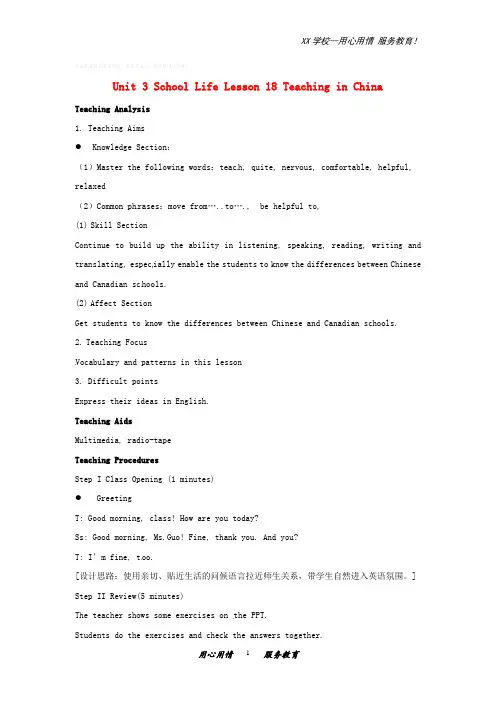
精品基础教育教学资料,请参考使用,祝你取得好成绩!Unit 3 School Life Lesson 18 Teaching in China Teaching Analysis1. Teaching Aims●Knowledge Section:(1)Master the following words:teac h, quite, nervous, comfortable, helpful, relaxed(2)Common ph rases:move from…..to…., be helpful to,(1)Skill SectionContinue to build up the ability in listening, speaking, reading, writing and translating, espec ially enable the students to know the differences between Chinese and Canadian sc hools.(2)Affect SectionGet students to know the differences between Chinese and Canadian schools.2.Teaching FocusVocabulary and patterns in this lesson3. Difficult pointsExpress their ideas in English.Teaching AidsMultimedia, radio-tapeTeaching ProceduresStep I Class Opening (1 minutes)● GreetingT: Good morning, class! How are you today?Ss: Good morning, Ms.Guo! Fine, thank you. And you?T: I’m fine, t oo.[设计思路:使用亲切、贴近生活的问候语言拉近师生关系,带学生自然进入英语氛围。
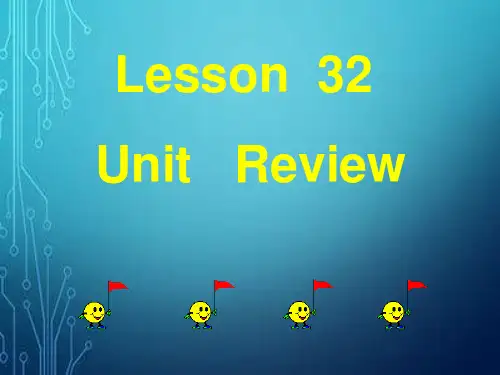
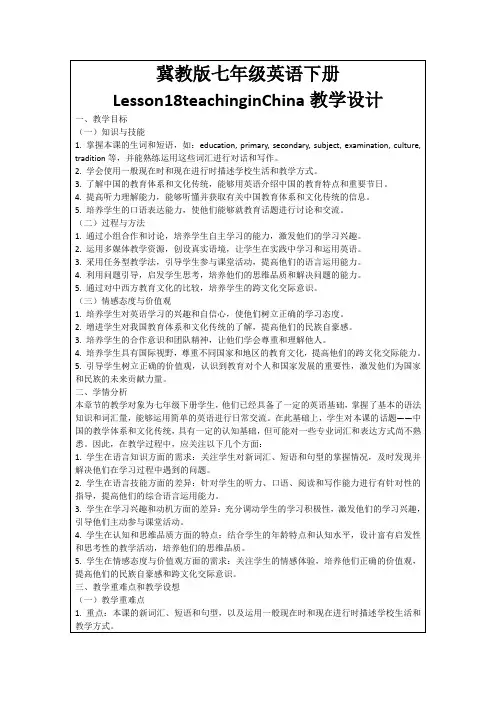
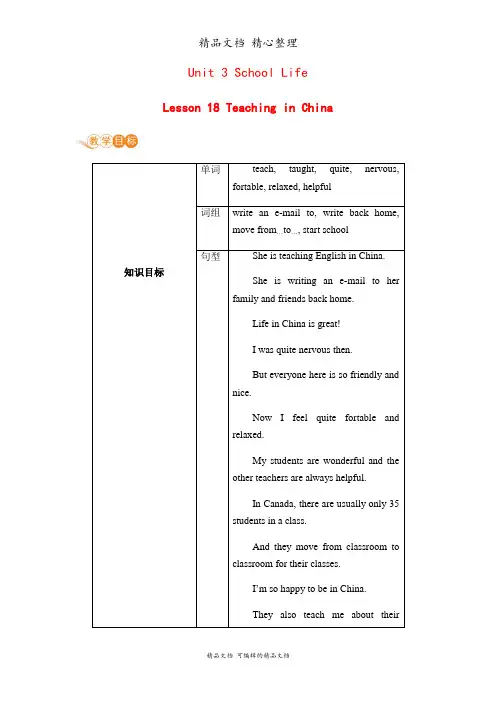
Unit 3 School LifeLesson 18 Teaching in China单词teach, taught, quite, nervous,理解文章内容,能够用英语写电子邮件。
正确使用本课的词和短语,分辨、会用teach, taught, quite, nervous, fortable, relaxed, helpful,write an e-mail to, write back home, move from…to…, start school。
Step 1.Lead inLeading in 【情景1】Begin the class with a free talk.Teacher asks the students questions about how to write an English e-mail.Ask students questions like these,“Do you write e-mails? What do you think of e-mails? How do you feel when you get to a new place? How do you feel about the people in the new place?”T:Do you write e-mails?S1:Yes, I do.T:What do you think of e-mails?S1:They are fast and free.S2:Others can get our e-mails in a few seconds.T:Oh, when do you write them?S3:When I have some special feelings, I write them in my blog.T:How do you feel when you get to a new place?S4:I feel nervous.T:How do you feel about the people in the new place?S5:Most of them are very friendly.…Leading in 【情景2】Group work:Ask the students to work in groups and discuss the following question:Do you know the differences between Chinese schools and Western schools?S1:What do you know about the differences between Chinese schools and Western schools?S2:The Chinese students have classes in the same classroom, but in Western countries, the students move from one classroom to another.S1:Are there any other differences?S2:Chinese classes have more students.S3:Chinese students work harder than Western students.S4:Western students have more activities after class.S5:Western students do a lot to help others in their free time.S6:Chinese students have more time to study.…Group 1:There are many differences between Chinese classes and Westernclasses.Chinese students have classes in the same classroom, but in Western countries, the students move from one classroom to another.Chinese classes have more students.Chinese students work harder than Western students.Western students have more activities after class.Western students do a lot to help others in their free time.Chinese students have more time to study.Step 2.Presentation1.Show the students objects or pictures and learn the new words and expressions in this part:teach, taught, quite, nervous, fortable, relaxed, helpful,write an e-mail to, write back home, move from…to…, start school.Show a picture to the students.Point to the picture and ask:T:Do you like teaching?S1:Yes.It’s interesting.T:Very good.Now read after me “teach”.S:Teach.T:How do you feel now?S2:I feel quite cold.T:Now read after me “quite”.S:Quite.…2.Ask the students to make sentences with the new words and phrases.S3:I will take an exam tomorrow.I feel quite nervous.What should I do?S4:Have a good sleep, and you will feel relaxed.S5:Is sleeping helpful to me?S6:Yes,I think so.S7:I will move to a new place next month.S8:Can you write an e-mail to me after you move to a new place?S9:Of course,I will.…Give the students chances to make sentences or make up dialogues.Step 5.Practice Writing1.Ask the students to retell the e-mail.2.Ask the students to write an e-mail about his/her opinions of studying in Western countries.Every group chooses the best to read in front of the class.When the students are writing, the teacher should walk around and give them advice.Step 6.plete Let’s Do It!Exercise 1 is used to practice the students’listening.We have finished it in listening part.Ask the students to finish Exercise 2 and Exercise 3 by themselves in class.Teacher checks their answers in class.Step 7.TaskGroup work:Let’s Do It! Exercise 4.Work in groups.Interview your classmates and fill in the table.Example:A:Do you do your homework?B:Yes.I always do my homework.A:Do you help out at home?B:Yes.I sometimes wash the dishes.Task tips:Where/When did you go?Who did you go with? What did you see and experience? Did you eat any traditional or special food?1.他正在卧室里给他的姑姑写电子邮件。
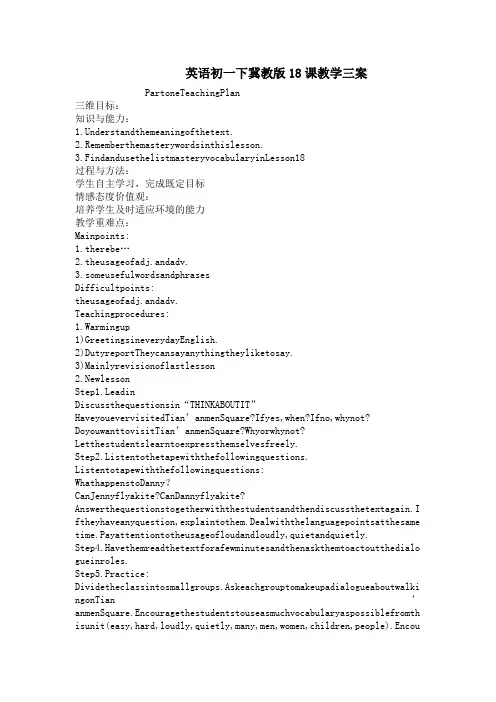
英语初一下冀教版18课教学三案PartoneTeachingPlan三维目标:知识与能力:1.Understandthemeaningofthetext.2.Rememberthemasterywordsinthislesson.3.FindandusethelistmasteryvocabularyinLesson18过程与方法:学生自主学习,完成既定目标情感态度价值观:培养学生及时适应环境的能力教学重难点:Mainpoints:1.therebe…2.theusageofadj.andadv.3.someusefulwordsandphrasesDifficultpoints:theusageofadj.andadv.Teachingprocedures:1.Warmingup1)GreetingsineverydayEnglish.2)DutyreportTheycansayanythingtheyliketosay.3)Mainlyrevisionoflastlesson2.NewlessonStep1.LeadinDiscussthequestionsin“THINKABOUTIT”HaveyouevervisitedTian’anmenSquare?Ifyes,when?Ifno,whynot? DoyouwanttovisitTian’anmenSquare?Whyorwhynot? Letthestudentslearntoexpressthemselvesfreely.Step2.Listentothetapewiththefollowingquestions. Listentotapewiththefollowingquestions:WhathappenstoDanny?CanJennyflyakite?CanDannyflyakite? Answerthequestionstogetherwiththestudentsandthendiscussthetextagain.I ftheyhaveanyquestion,explaintothem.Dealwiththelanguagepointsatthesame time.Payattentiontotheusageofloudandloudly,quietandquietly.Step4.Havethemreadthetextforafewminutesandthenaskthemtoactoutthedialo gueinroles.Step5.Practice:Dividetheclassintosmallgroups.Askeachgrouptomakeupadialogueaboutwalki ngonTian’anmenSquare.Encouragethestudentstouseasmuchvocabularyaspossiblefromth isunit(easy,hard,loudly,quietly,many,men,women,children,people).EncouragethestudentstobeactiveandpraisethemfortalkingriskswithEnglish!Them oretheyexperiment,themoretheylearn.LET’SDOITWorkwithapartner.DrawamapofTian’anmenSquare.Describeyourmapstoeachother.Whatarethepeopledoing?Trytous eloudly,quietly,slowlyandquickly.Step6.ExerciseIftimepermits,doNumber2inworkbook.Homework:1.UnderstandthemeaningofthetextofLesson182.FinishtheworkbookinLesson183.ThenextreadingParttwo学案学习目标:1.Masterywords:laugh,fly,hard,quietly,worry,put2.Learnadialogueaboutflyingakite3.someusefulwords学习重难点:Mainpoints:1.therebe…2.theusageofadj.andadv.3.someusefulwordsandphrasesDifficultpoints:Theusageofadj.andadv.Keypoints:1.therebe…2.theusageofadj.andadv.3.someusefulwordsandphrases课前预习:1. Learnthenewwordsbythemselves,findoutthesentenseswiththenewwords.2. Readthenewtextandtranslateit.新知学习【一】Listenandanswer1.CanJennyflyakite?Yes,shecan.2.CanDannyflyakite?No,hecan’t.3.WhathappenstoDanny?Hehurtshisarm.读课文,判断正误。
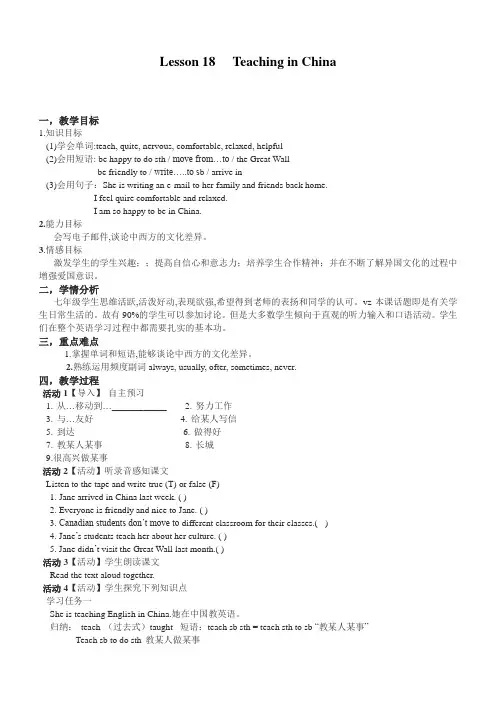
Lesson 18 Teaching in China一,教学目标1.知识目标(1)学会单词:teach, quite, nervous, comfortable, relaxed, helpful(2)会用短语: be happy to do sth / move from…to / the Great Wallbe friendly to / write…..to s b / arrive in(3)会用句子:She is writing an e-mail to her family and friends back home.I feel quire comfortable and relaxed.I am so happy to be in China.2.能力目标会写电子邮件,谈论中西方的文化差异。
3.情感目标激发学生的学生兴趣;;提高自信心和意志力;培养学生合作精神;并在不断了解异国文化的过程中增强爱国意识。
二,学情分析七年级学生思维活跃,活泼好动,表现欲强,希望得到老师的表扬和同学的认可。
vz本课话题即是有关学生日常生活的。
故有90%的学生可以参加讨论。
但是大多数学生倾向于直观的听力输入和口语活动。
学生们在整个英语学习过程中都需要扎实的基本功。
三,重点难点1.掌握单词和短语,能够谈论中西方的文化差异。
2.熟练运用频度副词always, usually, ofter, sometimes, never.四,教学过程活动1【导入】自主预习1. 从…移动到…____________2. 努力工作______________3. 与…友好___________4. 给某人写信______________5. 到达__________________6. 做得好_____________7. 教某人某事______________ 8. 长城____________________9.很高兴做某事____________活动2【活动】听录音感知课文Listen to the tape and write true (T) or false (F)1. Jane arrived in China last week. ( )2. Everyone is friendly and nice to Jane. ( )3. Canadian students don’t move to different classroom for their classes.( )4. Jane’s students teach her about her culture. ( )5. Jane didn’t visit the Great Wall last month.( )活动3【活动】学生朗读课文Read the text aloud together.活动4【活动】学生探究下列知识点学习任务一She is teaching English in China.她在中国教英语。
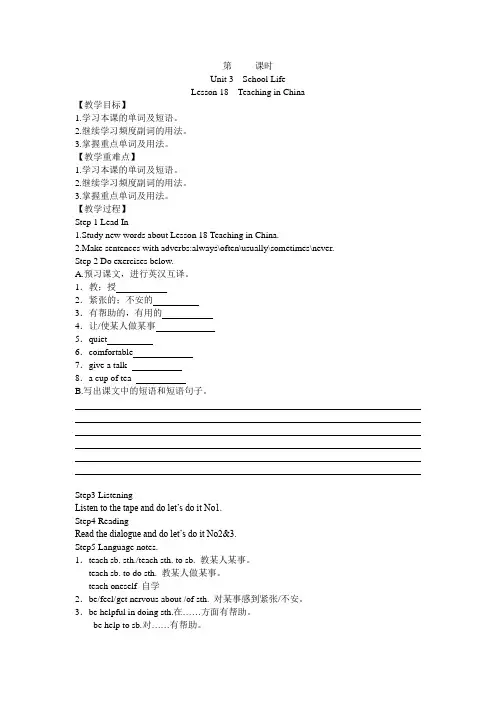
第课时Unit 3 School LifeLesson 18 Teaching in China【教学目标】1.学习本课的单词及短语。
2.继续学习频度副词的用法。
3.掌握重点单词及用法。
【教学重难点】1.学习本课的单词及短语。
2.继续学习频度副词的用法。
3.掌握重点单词及用法。
【教学过程】Step 1 Lead In1.Study new words about Lesson 18 Teaching in China.2.Make sentences with adverbs:always\often\usually\sometimes\never. Step 2 Do exercises below.A.预习课文,进行英汉互译。
1.教;授2.紧张的;不安的3.有帮助的,有用的4.让/使某人做某事5.quiet6.comfortable7.give a talk8.a cup of teaB.写出课文中的短语和短语句子。
Step3 ListeningListen to the tape and do let’s do it No1.Step4 ReadingRead the dialogue and do let’s do it No2&3.Step5 Language notes.1.teach sb. sth./teach sth. to sb. 教某人某事。
teach sb. to do sth. 教某人做某事。
teach oneself 自学2.be/feel/get nervous about /of sth. 对某事感到紧张/不安。
3.be helpful in doing sth.在……方面有帮助。
be help to sb.对……有帮助。
step 6 Exercises.A.根据句意及首字母提示填空。
1.The teacher t us art last year.2.Tom does the things q happily.3.It’s very c to travel by train now.4.Listening to light music is a r way.5.The boy was so n that he couldn’t say anything in the interview.B.用括号内所给单词的适当形式填空。
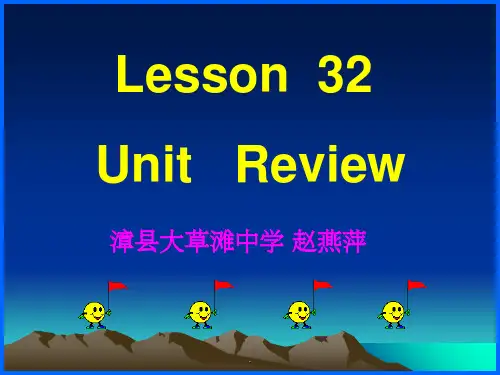
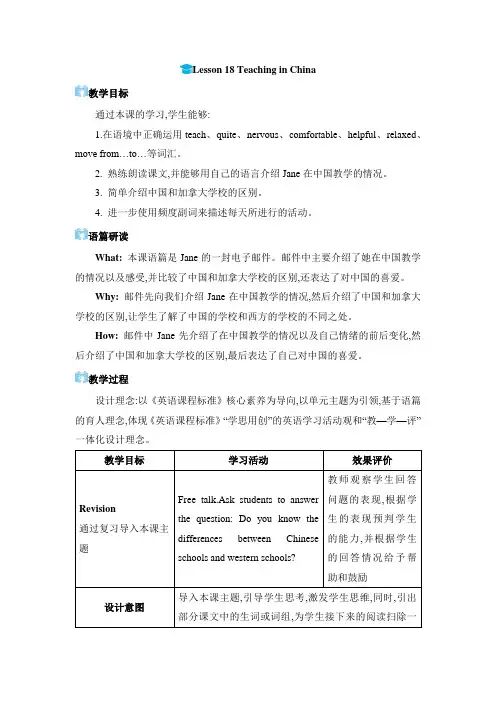
Lesson 18 Teaching in China教学目标通过本课的学习,学生能够:1.在语境中正确运用teach、quite、nervous、comfortable、helpful、relaxed、move from…to…等词汇。
2. 熟练朗读课文,并能够用自己的语言介绍Jane在中国教学的情况。
3. 简单介绍中国和加拿大学校的区别。
4. 进一步使用频度副词来描述每天所进行的活动。
语篇研读What:本课语篇是Jane的一封电子邮件。
邮件中主要介绍了她在中国教学的情况以及感受,并比较了中国和加拿大学校的区别,还表达了对中国的喜爱。
Why:邮件先向我们介绍Jane在中国教学的情况,然后介绍了中国和加拿大学校的区别,让学生了解了中国的学校和西方的学校的不同之处。
How:邮件中Jane先介绍了在中国教学的情况以及自己情绪的前后变化,然后介绍了中国和加拿大学校的区别,最后表达了自己对中国的喜爱。
教学过程设计理念:以《英语课程标准》核心素养为导向,以单元主题为引领,基于语篇的育人理念,体现《英语课程标准》“学思用创”的英语学习活动观和“教—学—评”一体化设计理念。
续表设计意图练习翻译句子,考查学生对本课重点单词或短语的掌握情况,以便有针对性地布置作业【应用实践】板书设计Lesson 18 Teaching in ChinaJane’s feelingsbefore: quite nervousafter: quite comfortable and relaxedDifferences between studentsChinese and Canadian schools teacherslanguages作业设计基础型作业:Finish Exercise 2 &3 on page 45.实践型作业:Retell the differences between Chinese and Canadian schools 教学反思。
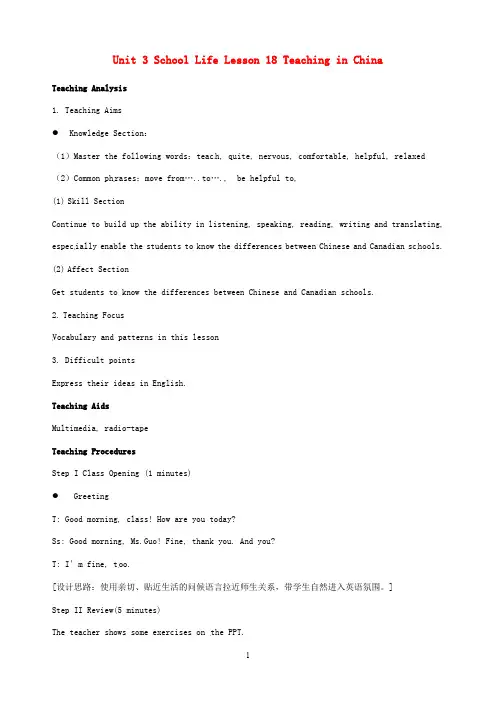
Unit 3 School Life Lesson 18 Teaching in ChinaTeaching Analysis1. Teaching Aims●Knowledge Section:(1)Master the following words:teac h, quite, nervous, comfortable, helpful, relaxed (2)Common ph rases:move from…..to…., be helpful to,(1)Skill SectionContinue to build up the ability in listening, speaking, reading, writing and translating, espec ially enable the students to know the differences between Chinese and Canadian sc hools.(2)Affect SectionGet students to know the differences between Chinese and Canadian schools.2.Teaching FocusVocabulary and patterns in this lesson3. Difficult pointsExpress their ideas in English.Teaching AidsMultimedia, radio-tapeTeaching ProceduresStep I Class Opening (1 minutes)● GreetingT: Good morning, class! How are you today?Ss: Good morning, Ms.Guo! Fine, thank you. And you?T: I’m fine, t oo.[设计思路:使用亲切、贴近生活的问候语言拉近师生关系,带学生自然进入英语氛围。
Lesson 18 Teaching in ChinaI.Teaching aims.1.Master the key words and phrases and try to use them.(important points)2.Enable Ss to read the text and understand the meaning of the text. Enable them to talk about the differences between the schools in China and in Canada. (important points and hard points)3.Encourage the class to speak English as much as possible.II.Teaching procedures.Step 1: Class opening.1.Greetings.2.Duty report.Step 2: Warming up.Talk about our school life .e.g. There are 33 students in our class. We usually come to school at 6:50 and finish school at 18:00.Step 3: Listening.1.Play the tape, help Ss read the new words and the phrases. Encourage Ss to make sentences with them.2.Play the tape again, help Ss read the text and answer the questions given. Then check the answers together.Step 4: Reading.Have Ss read the text in groups. Then volunteers read aloud paragraph by paragraph. Show key useful expressions on Bb.1.teach sb.sth. teach sb. to do sth.2.quite nervous3.so friendly and nice4.be helpful5.move from… to …6.start school finish schoolStep 5: Practice.1.Read the text aloud, understand the meaning of the text.2.Have Ss complete the exercises given, then check the answers together.Step 6: Summary.Step 7:Homework.1.Copy and recite the new words and phrases(3+1)2.Read the text aloud and understand the meaning of it.Blackboard design:Lesson 18 Teaching in Chinaeful expressions:1.teach sb.sth. teach sb. to do sth.2.quite nervous3.so friendly and nice4.be helpful5.move from… to …6.start school finish schoolII.Differences between schools in China and Canada:Schools in China: over 35 students; teachers move for classesSchools in Canada: only 35 students; students move for classesTeaching reflection:课堂中的每一个环节都应设计相应的练习题,让学生有目的的去说去听去做;课堂各环节连接紧凑,过渡自然;读的练习时间充足但对于知识的运用给的时间略少,以后需注意合理分配课堂时间。
Lesson18 Teaching in China (冀教版)教学设计Lesson 18 Teaching in China.学习目标:★能够丰富并掌握有关校园生活的词汇.★★能够听懂有关于校园生活的对话.★★★能够运用有关于校园生活的词汇及其句型.阅读理解:1.自主快速阅读课文,回答三个小问题,初步感知课文内容,并集体交流答案,3分钟。
1)、Where is Jane from ? He is from Canada.2)、What is she teaching in China?She is teaching English.3)、Where did she go last month?She visited the Great Wall .2.师友自主细读课文判断正确的填T错误的填F,互助小组讨论,全班交流、纠正,3分钟。
1)Jane arrived in China last week.( ) 2)Everyone is friendly and nice to Jane. ( ) 3)Canadian students don’t m ove to different classrooms for their classes. ( ) 4)Jane’s students teach her about their culture. ( )3.根据课文内容找到加拿大学校与中国学校的不同。
先自主完成,再师友互助交流,然后全班交流、补充,3分钟。
China The teachers move from classroom to classroomfor classes.There are only 35 students in a class.{There are many students in a class, usually more than 35.Canada The students move from classroom to classroomfor classes.{III掌握生词:4.New words:默写下列单词,师友互助检查,3分钟。
Lesson 18 Teaching in China1.知识目标(1)学会单词: teach, quite, nervous, comfortable, relaxed, helpful(2)会用短语:1. be happy to do 2. move from…to 3.be friendly to4. write …..to sb 6.arrive in(3)会用句型:1. She is writing an e-mail to her family and friends back home.2. I feel quite comfortable and relaxed.3. I am so happy to be in China.2.能力目标会写电子邮件,谈论中西方的文化差异。
3.情感目标激发学生的学生兴趣;提高自信心和意志力;培养学生合作精神;并在不断了解异国文化的过程中增强爱国意识。
Lesson structure:Step 1 GreetingCheck the number of the students.Step2 ReviewCheck the text of last lesson. By translating the sentences1.We are talking about our study now.2.We hope to go to the moon someday.3.Don’t worry about my study. (同义句)。
4.Yao Ming is interested in playing basketball5.I learnt a lot about the history of China on the trip to the Silk Road.6.There are many different kinds of food in Huiyou supermarket.7.We are excited to hear the exciting news.8.I made a video about our sport meeting.9.There is a piece of paper.10.We won eighth place at our school sport meet. We did a good job.(let students translate the sentences to improve their spoken English.)Step 3 let students learn the learning goals.(Using the ppt)Step 4 Learn the new words (using the ppt)Step 5 ListeningListen to the tape and write T or F(Look at ppt)Step 6 Work in groups :Read the text twice and finish the task (Let’s do it)Step 7 Work in groups (come to Part 4)Step 8 What you have learnt.Step 9 Homework板书设计Lessons 18 Teaching in ChinaTeach quite nervous comfortable helpful Relax relaxed relaxingIn Canada , there are usually only 35 students in a class.I arrived two months agoAnd they move from classroom to classroom for their classes.They usually start school at 8:00 a.m. and finish at 5:00 p.m。